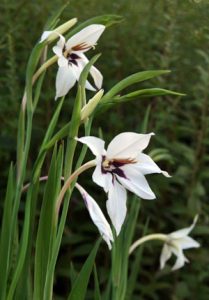
This interesting species is not an orchid but is in the Iris family. It was originally described as Acidanthera bicolor and is still often listed as such, but it is now named Gladiolus murielae (sometimes incorrectly seen as G. callianthus). Some of the many common names, besides peacock orchid, given to this flower include Abyssinian glad, fragrant gladiolus, peacock lily and sword lily. This “summer bulb” actually has a globose corm rather than a true bulb. It is considered an heirloom bulb, as it was blooming in Boston by 1888 – only 44 years after it was first collected.
Native to the mountains of tropical East Africa, G. murielae is most common in northern Ethiopia but occurs in scattered locations south to Malawi and
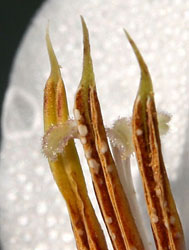
central Mozambique. In the wild, it grows on cliffs or in rocky outcrops in thin soil where few other plants grow. G. murielae is easily confused with G. aequinoctialis (=A. divina) from tropical West Africa, that has a scattered distribution centered in Sierra Leone and the highlands of Cameroon. This species can be taller (to 4 feet), with slightly wider leaves and a few more flowers per stem but otherwise is very similar and hard to separate without knowing the source of the plants. The two are best distinguished by leaf texture and venation (G. murielae foliage is softer with weakly developed secondary veins) and the size of the anther apiculi (longer, rigid filiform apiculi for G. murielae; shorter acute appendages for G. aequinoctialis). The latter species also tends to bloom later in the year but some variants will bloom at the same time as G. murielae.
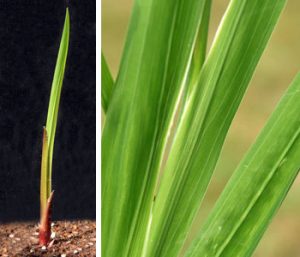
In the wild G. murielae grows 1 to 2 feet tall, with four to eight leaves. The relatively soft-textured leaves are up to ½” wide, flat, tall and narrow to a point on the end – just like a sword. The stems are fairly strong but may require staking if planted in an unsheltered spot subject to strong winds or in too much shade. This plant is hardy only to about 10˚F, so it can remain in the ground in zones 7-11, but is easily overwintered indoors in colder climates.
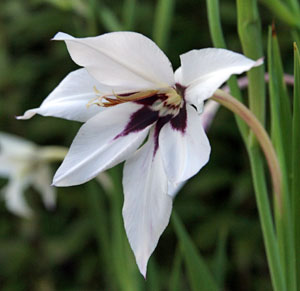
These plants require a longer growing season than common hybrid gladiolus and bloom from mid- to late summer, depending on when they were planted. The flowers are similar to the familiar gladiolus but are more delicate and relaxed than the showy hybrids. The 2-3” star-shaped, white flowers with 6 equal tepals have a deep purple blotch in the center and hang slightly downwards on the arching pedicel (the stalk that supports the flower). Each stem produces several flowers that open one at a time starting from the bottom of the spike, over a period of three to four weeks. The individual flowers last a few days and make long-lasting cut flowers. They are deliciously fragrant with a light scent reminiscent of gardenia or jasmine that is stronger at night. The plants should be covered at night to protect the flowers if they have not finished flowering by the first frost.
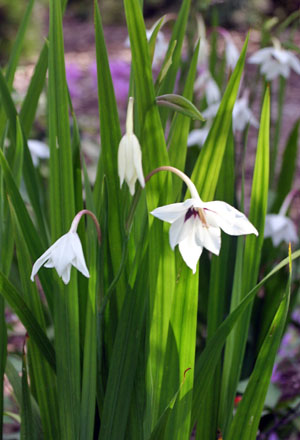
Peacock orchid is easily grown in the ground or in containers. The tall, sword-like foliage provides vertical interest and textural contrast to many other plants and works well in informal or cottage gardens, in beds and in mixed borders. Try to position them where their fragrance will be appreciated. For the highest impact in the landscape, plant them in masses (10 to 25 corms) in clusters, not in straight rows. They combine nicely with short, relaxed grasses such as fountain grass (Pennisetum alopecuroides) or prairie dropseed (Sporobolous heterolepsis) and airy Gaura lindheimeri. Place them next to plants with dark purple foliage to emphasize the maroon flower centers. Because of their narrow profile they are easy to tuck into small or tightly planted gardens. If used in a mixed container, choose companions that like heat without the need for excess water, such as licorice plant (Helichrysum petiolare) or blue fan flower (Scaveola). You can also plant them in their own container and then group with other plants that have different water requirements.
This Gladiolus does best in full sun and well-drained soil. They will grow in part shade but the flowers will be smaller or not even bloom. They can be planted a week or two before the last frost, but since they prefer warm soil, planting is best delayed until soil temperatures are above 50˚F. To get a head start, they can be planted indoors about a month before the average last frost and then transplanted outdoors without breaking up the soil ball.

Peacock orchid is usually offered in packages of 5 or more bulbs. The dark red-brown corms are relatively small – only about 3/4 inch in diameter (those of G. aequinoctialis are larger, over an inch in diameter). Plant the corms 2-6” deep, with larger corms planted deeper. Space the corms 4-6” apart, preferably in groups of at least five. Keep well watered but cut back on watering after the plants have flowered.
In the fall, dig the corms after a frost kills the foliage and before the soil freezes. Cut the stems back to about 4” and cure the corms in a dry shady area for about two weeks until the tops dry and can be twisted off. Then store like you would a gladiolus corm, in a cool (40-60˚F), dry, well-ventilated area in dry peat moss, perlite or vermiculite.
This species is most commonly propagated by division of the corms that multiply during the growing season. The corms can be separated in the fall or at planting time. The plants also produce small offset cormels at the base, which typically require two years to reach flowering size. It can also be grown from seed but those plants take longer to flower.
– Susan Mahr, University of Wisconsin – Madison





 Marigolds
Marigolds Create a Butterfly Garden
Create a Butterfly Garden Plant Flowers to Encourage Beneficial Insects
Plant Flowers to Encourage Beneficial Insects Forcing Bulbs
Forcing Bulbs


